Regulated recovery of pulsatile growth hormone secretion from negative feedback: a preclinical investigation
- PMID: 21795635
- PMCID: PMC3197337
- DOI: 10.1152/ajpregu.00293.2011
Regulated recovery of pulsatile growth hormone secretion from negative feedback: a preclinical investigation
Abstract
Although stimulatory (feedforward) and inhibitory (feedback) dynamics jointly control neurohormone secretion, the factors that supervise feedback restraint are poorly understood. To parse the regulation of growth hormone (GH) escape from negative feedback, 25 healthy men and women were studied eight times each during an experimental GH feedback clamp. The clamp comprised combined bolus infusion of GH or saline and continuous stimulation by saline GH-releasing hormone (GHRH), GHRP-2, or both peptides after randomly ordered supplementation with placebo (both sexes) vs. E(2) (estrogen; women) and T (testosterone; men). Endpoints were GH pulsatility and entropy (a model-free measure of feedback quenching). Gender determined recovery of pulsatile GH secretion from negative feedback in all four secretagog regimens (0.003 ≤ P ≤ 0.017 for women>men). Peptidyl secretagog controlled the mass, number, and duration of feedback-inhibited GH secretory bursts (each, P < 0.001). E(2)/T administration potentiated both pulsatile (P = 0.006) and entropic (P < 0.001) modes of GH recovery. IGF-I positively predicted the escape of GH secretory burst number and mode (P = 0.022), whereas body mass index negatively forecast GH secretory burst number and mass (P = 0.005). The composite of gender, body mass index, E(2), IGF-I, and peptidyl secretagog strongly regulates the escape of pulsatile and entropic GH secretion from autonegative feedback. The ensemble factors identified in this preclinical investigation enlarge the dynamic model of GH control in humans.
Figures
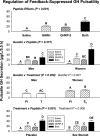
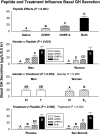
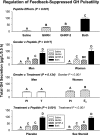

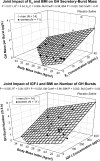
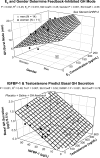

Similar articles
-
Complex regulation of GH autofeedback under dual-peptide drive: studies under a pharmacological GH and sex steroid clamp.Am J Physiol Endocrinol Metab. 2011 Jun;300(6):E1158-65. doi: 10.1152/ajpendo.00054.2011. Epub 2011 Apr 5. Am J Physiol Endocrinol Metab. 2011. PMID: 21467302 Free PMC article. Clinical Trial.
-
Impact of estradiol supplementation on dual peptidyl drive of GH secretion in postmenopausal women.J Clin Endocrinol Metab. 2002 Feb;87(2):859-66. doi: 10.1210/jcem.87.2.8251. J Clin Endocrinol Metab. 2002. PMID: 11836333 Clinical Trial.
-
Continuous 24-hour intravenous infusion of recombinant human growth hormone (GH)-releasing hormone-(1-44)-amide augments pulsatile, entropic, and daily rhythmic GH secretion in postmenopausal women equally in the estrogen-withdrawn and estrogen-supplemented states.J Clin Endocrinol Metab. 2001 Feb;86(2):700-12. doi: 10.1210/jcem.86.2.7195. J Clin Endocrinol Metab. 2001. PMID: 11158034
-
Sex-steroid modulation of growth hormone (GH) secretory control: three-peptide ensemble regulation under dual feedback restraint by GH and IGF-I.Endocrine. 2003 Oct;22(1):25-40. doi: 10.1385/ENDO:22:1:25. Endocrine. 2003. PMID: 14610296 Review.
-
Physiological regulation of the human growth hormone (GH)-insulin-like growth factor type I (IGF-I) axis: predominant impact of age, obesity, gonadal function, and sleep.Sleep. 1996 Dec;19(10 Suppl):S221-4. doi: 10.1093/sleep/19.suppl_10.s221. Sleep. 1996. PMID: 9085516 Review.
Cited by
-
Network identification of hormonal regulation.PLoS One. 2014 May 22;9(5):e96284. doi: 10.1371/journal.pone.0096284. eCollection 2014. PLoS One. 2014. PMID: 24852517 Free PMC article.
References
-
- Anderson SM, Shah N, Evans WS, Patrie JT, Bowers CY, Veldhuis JD. Short-term estradiol supplementation augments growth hormone (GH) secretory responsiveness to dose-varying GH-releasing peptide infusions in healthy postmenopausal women. J Clin Endocrinol Metab 86: 551–560, 2001 - PubMed
-
- Bowers CY, Granda-Ayala R. GHRP-2, GHRH and SRIF interrelationships during chronic administration of GHRP-2 to humans. J Pediatr Endocrinol Metab 9, Suppl 3: 261–270, 1996 - PubMed
-
- Bray MJ, Vick TM, Shah N, Anderson SM, Rice LW, Iranmanesh A, Evans WS, Veldhuis JD. Short-term estradiol replacement in postmenopausal women selectively mutes somatostatin's dose-dependent inhibition of fasting growth hormone secretion. J Clin Endocrinol Metab 86: 3143–3149, 2001 - PubMed
-
- Broglio F, Benso A, Castiglioni C, Gottero C, Prodam F, Destefanis S, Gauna C, van der Lely AJ, Deghenghi R, Boghen M, Arvat E, Ghigo E. The endocrine response to ghrelin as a function of gender in humans in young and elderly subjects. J Clin Endocrinol Metab 88: 1537–1542, 2003 - PubMed
-
- Carlsson LM, Clark RG, Robinson IC. Sex difference in growth hormone feedback in the rat. J Endocrinol 126: 27–35, 1990 - PubMed
Publication types
MeSH terms
Substances
Grants and funding
LinkOut - more resources
Full Text Sources
Other Literature Sources

